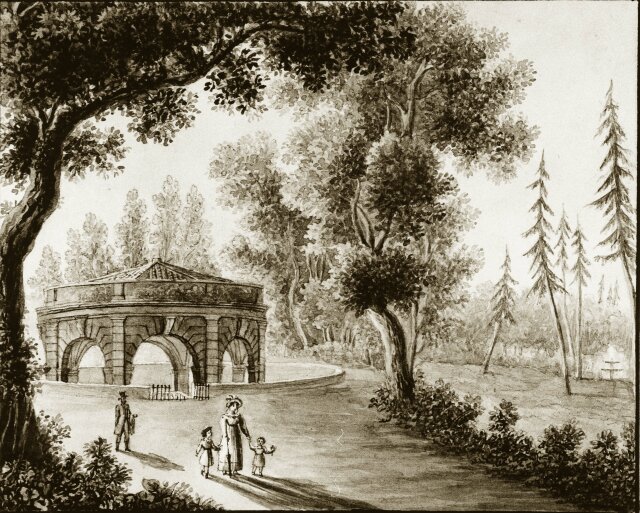The Location
The architectural complex comprising the grotto and the Loggia dei Vini was constructed over nearly a decade, beginning in 1609, alongside the building of the Casino Nobile at Villa Borghese. The Loggia is an especially unique structure, purpose-built to host the banquets and gatherings of Cardinal Scipione Borghese (1575–1633), nephew of Pope Paul V (1605-1621). This “tinello de’ li gentil’ homini,” as it was sometimes called in 17th-century sources, was seamlessly integrated into one of the twenty-three divisions that compartmentalized the so-called “First Enclosure,” a formal garden area of the park. The loggia formed a scenographic backdrop for one of the side avenues intersecting the main driveway leading to the Casino Nobile, making it highly visible to all visitors who came to see the cardinal. Accessible via a shaded path and a double staircase, the pavilion’s sunken area was surrounded by high ivy-covered walls, described by Manilli as a “tapestry suited to the residence of the god Bacchus.” (“Tappezzeria proporzionata all’habitazione del Dio Bacco” Manilli, 1650, p. 22).

Archival sources reveal two distinct construction phases. By 1609, under the direction of architect Flaminio Ponzio, the grotto—a “copious dispensary of nectars and ambrosias” (“copiosissima dispensa di nettari e d’ambrosie,” Manilli, 1650, p. 24)—was excavated to store wine and connected to the Casino’s kitchens via an underground passage. Between 1612 and 1618, the loggia was constructed as an oval structure with eight large arches supported by pillars of Tusculan tuff, known as pietra sperone, with bases and capitals in travertine. Accessible via a broad stairway, the loggia connected to the grotto below, overseen by Giovanni Vasanzio, who succeeded Ponzio as villa architect in 1613 after Ponzio's death.
Numerous payment records document the presence of stonecutter Vincenzo Soncino on-site between 1612 and 1613 for the carving of the tuff blocks (Borghese Archive). In 1617, the stucco decoration on the pendentives and the oval frame of the vault fresco was completed, attributed to master masons and stucco workers Marcantonio and Pietro Fontana, in collaboration with Santi Fiamberti. These artists were active during the same period at the Uccelliera in Villa Borghese and other Borghese commissions, including the Pauline Chapel at the Quirinal and the Church of San Crisogono.

The original splendor of the complex is attested to by literary sources (Manilli, 1650; Montelatici, 1700), which describe two Egyptian sphinxes flanking the access ramp to the sunken area—now housed at the Ny Carlsberg Glyptotek in Copenhagen—a rustic fountain beneath the staircase featuring a statue of a river deity, fragments of which survive in tufa, and eight large peperino stone birds crowning the roof. These birds were crafted by the stonecutters Agostino and Belardino Radi, alongside Lorenzo Malvisti. Marble tables, intended for use as “credence and wine stands,” lined the perimeter of the sunken area, while a large white marble table stood at the center of the loggia. Also created by the Radi brothers and Malvisti, this table featured carved channels designed to allow running water to keep glasses cool. To further impress guests, a mechanical device was installed in the ceiling to release a shower of scented petals over the diners at the end of the feast.

Between 1617 and 1618, the fresco depicting The Banquet of the Gods was painted on the vault by Archita Ricci, an artist born in Urbino who was active at the Church of San Sebastiano fuori le Mura and involved in other projects under Borghese patronage during this period (Santolini, 2003). A document from the Borghese archive, dated October 20, 1617, mentions the construction of “scaffolding for the vault of the loggia to paint the pendentives,” providing a valuable terminus post quem for the beginning of the vault’s pictorial decoration. Montelatici’s description, crucial for reconstructing the fresco’s iconography, notes that the painter adorned the walls between the arches with “the nine Muses in life-size, holding musical instruments, with heads framed by mask-shaped decorations" and, on the vault, "the banquet of the gods, set within an oval adorned with finely crafted stucco garlands.”
Bibliography:
A. Campitelli, Villa Borghese da Giardino del Principe a Parco dei Romani, Rome 2003, p. 91-95.
E. Federico, "Il tinello de’ li gentil’homini", in Mura di Roma. Memorie e visioni della città, Rome 2018, p. 51-52.
B.M. Santese, "Grotta dei vini di Villa Borghese", in V. Cazzato, M. Fagiolo, M.A. Giusti (eds.), Atlante delle grotte e dei ninfei in Italia, Milan 2001, p. 209-212.
B.M. Santese, "La grotta dei vini a Villa Borghese", in C. Biasimi Selvaggi (ed.), Degustazioni d’arte. Enologia mitica, spirituale, simbolica e metafisica nelle collezioni pubbliche di Roma, Rome 2004, p. 10-12.
S. Santolini, "Il Convito degli Dei nella grotta dei vini", in C. Biasimi Selvaggi (ed.), Degustazioni d’arte. Enologia mitica, spirituale, simbolica e metafisica nelle collezioni pubbliche di Roma, Rome 2004, p. 14-17.


